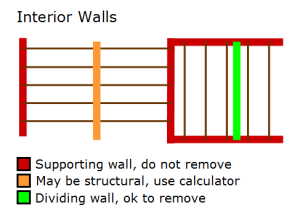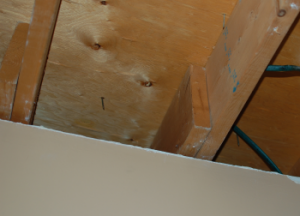Removing Interior Walls: A Structural Wall Detection Primer
One of the most tempting options in home renovations is to remove an entire wall. The advantages are manifold:
- Simplify the floor plan to create a more spacious feeling to the area,
- Open the layout to light from more directions,
- Increase traffic flow options.
You are limited by whether or not the wall is structural (or “load bearing”) or not. In a nutshell, if a wall is holding up the floor above it, or the roof, you can’t remove it without creating an alternative load-bearing strategy. If you do, the floor and possibly even the entire house might collapse.
A non-structural wall is simply there to divide the space – it is basically a frame for drywall.
How to Tell a Structural Wall
The most obvious indicator of a structural wall is a wall that is echoed on multiple floors. If you have an I-Beam in your basement running in a certain direction, and walls in the exact same location on all the floors above it, the wall is likely structural and must stay.
Some house plans are more complex, however, and more detective work will be required. A structural wall will have floor joists or roof beams resting directly on top of it. For simplification purposes, we’ll be talking about floor joists from here on.
The first thing you will need to determine is which direction the floor joists run. Most people don’t have access to the original blueprints for the house, so you will need to do this in a couple of steps:
- Look at the drywall on the ceiling. Some drywall that is old or that was poorly installed will have ridges showing where it the drywall panel has been screwed or nailed to the floor joists.
- If you can’t tell visually, use a stud finder to locate the joists
- If you have a stippled or “popcorn” ceiling that prevents the use of a stud finder, use a drywall saw to open a small hole, and have a look.
If the wall runs parallel to the joists, the wall is almost certainly non-structural (there are some exceptions, however, see the photo to the right). If the direction of the joists is the same on both sides of the wall, the wall is very likely supporting them. You may be able to remove this wall – it depends on the span of the joists and the amount of weight they need to support. A calculator like this one can help you determine how far the joists can run without support. If the joists run in different directions on either side of the wall, it almost definite that the wall is supporting the ends of some of the joists, and must be kept. This is when the old adage is probably a good one: if in doubt, don’t do it.
In this video, you can follow Tim Carter of Ask The Builder as he goes through the process of determining a non-structural wall:
Demolition Alternative: Interior Windows
If you can’t take out the entire wall, you can still cut an interior window within a load bearing wall, provided you do it properly. This is a great technique for letting natural light get into shadowy areas, and for improving air circulation. I’ll be providing tips on building interior windows in a later post.
Before you Demolish
Non-structural walls may still contain electrical cables or possibly even plumbing. Non-structural walls are also sometimes used for air ducts – removing them may affect air flow or heating/cooling efficiency. Use an electrical tester or stud finder with an electrical tester to find electrical cables. Finding plumbing or ductwork can be trickier – it is mostly educated guesswork. Again, you will need to make small test holes in the drywall with a drywall saw to find out for sure.
Above all, if you are not 100% sure a wall can be removed, consult a residential structural engineer. It’s better to be safe than sorry.
by Jennifer Priest
Follow me on Google +



Pingback: Renovation Story: Full Kitchen Rebuild » housecraft()
Pingback: Decorator, Designer, and Architect: Differences for DIYers » housecraft()
Pingback: Renovation Project Planning Part 1: Overview » Housecraft: DIY House, Garden and Interior Design()